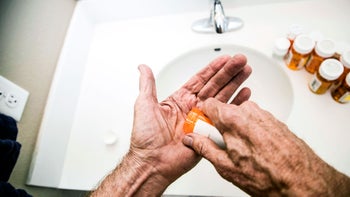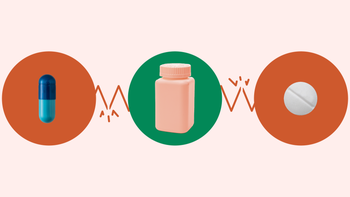
6 Foods That May Help Prevent Blood Clots — and a Few to Avoid
Key takeaways:
Research suggests that certain foods and ingredients — like olive oil, garlic, and ginger — may lower the chance of blood clots.
More research is needed to know how much of these types of foods to eat to have an effect on blood clotting.
No food directly thins the blood the way that medications do. If you’re at risk for a blood clot, it’s important to talk with your healthcare provider about both medication and diet changes to reduce your risk.
Table of contents

Food and diet can have a big effect on different health conditions. And blood clots are one of them. Some research has looked at whether certain foods can lower the chance of developing a blood clot.
If you have an increased risk for a blood clot and want to know how diet can help, this article may help. Here we look into the research and provide recommendations on how to incorporate some of these foods into your diet.
1. Olive oil
Olive oil can affect some of the cells and proteins in your blood that contribute to blood clotting.
A study of people with a body mass index (BMI) of over 30 showed that consuming olive oil at least once weekly reduced the activity of platelets. Platelets are the blood cells that bind together to help form clots. The effect was even greater when they consumed olive oil more than four times in one week (although the exact amount of olive oil wasn’t measured).
Virgin olive oil is also rich in antioxidants called phenols, which may affect several proteins in the blood that play a role in clotting.
A small study showed that when people with high cholesterol ate white bread with 40 mL of virgin olive oil that contained 400 parts per million (PPM) of phenols, they had lower amounts of factors in their blood that cause clots. When they ate white bread with virgin olive oil containing only 80 PPM of phenols, the effect was still there but it wasn’t as significant.
Sometimes the label on the bottle will say the phenol content — but not always. If you’re unsure, go for extra virgin olive oil (EVOO), which is known to have higher amounts of phenols.
EVOO also contains polyunsaturated fatty acids (PUFAs), a dietary fat that’s more heart healthy than other fats. Scientists think this could be why EVOO may protect the heart, prevent blood clots, and help regulate blood pressure.
For an easy way to incorporate more olive oil into your diet, try using it in place of butter at your next meal. This swap works well in cooking — like if you’re sautéing vegetables or making eggs. But it can also work well on top of something like bread or a baked potato.
2. Ginger
When scientists study ginger in the lab, it seems to have anti-clotting effects by preventing platelets from clumping together. But the studies on the effects of ginger on blood clots in people are mostly mixed.
Several studies have found that ginger has no effect on the likelihood of developing blood clots. Others have shown the opposite. One study looked at women who ate 5 g of raw ginger every day, and researchers saw a decrease in one of the blood proteins that usually promotes blood clots. A similar finding was seen in healthy males who ate 5 g of ginger twice a day.
It’s important to note that most studies on ginger looked at people who consumed it every day — and sometimes two to three times a day. Across eight total studies, serving sizes ranged from 3.6 g to 5 g. This amount of ginger looks different depending on the type of ginger used. But it’s about 2½ teaspoons of ground ginger, or 4-5 teaspoons of grated or freshly chopped ginger root.
But one of them was looking at larger portions of 10 g or 40 g daily. So this was a lot of ginger. Ginger was either dried, cooked, or raw, in capsules or mixed into something like custard.
Ginger root is generally considered safe. A daily intake of up to 4 g likely won’t cause any symptoms. But eating 6 g or more daily may lead to stomach upset.
3. Garlic
Garlic has several health benefits. And there’s some evidence to support that small amounts of garlic over time may help prevent the formation of blood clots.
One study showed that eating one clove of garlic (about 3 g) daily for 16 weeks led to a 80% reduction in thromboxane. Thromboxane is a substance produced by platelets that causes blood clotting.
Research done in the lab also suggests that garlic prevents platelets from clumping together and forming clots. But there’s no study that looks directly at the effects of garlic on blood clot risk. Either way, adding a clove of garlic to your home-cooked meals is still a good way to increase their flavor and nutrition content.
4. Cinnamon
Cinnamon contains coumarin, a compound that can prevent blood clots in the lab and in animal models. And additional studies have shown that other compounds in cinnamon prevent platelets from sticking together and forming clots.
But little research has been done to evaluate the effect of cinnamon on blood clots in people. And none of the existing studies provide a recommended dose for its potential blood thinning effects.
The few studies done in humans suggested that consuming 2 g to 6 g of cinnamon a day may protect against heart disease. And it may lower blood sugar levels in people with diabetes. So topping off your coffee or cereal with a teaspoon of cinnamon may lead to several heart health benefits beyond preventing blood clots.
5. Cayenne peppers
Cayenne peppers contain capsaicin. This is the compound that makes your mouth feel hot when you eat them. But researchers are exploring its multiple different health uses, too.
In the lab, it has been shown to have blood-thinning effects. Research shows that capsaicin prevents platelets from sticking together to form blood clots in mice.
But like the other foods above, few studies have looked at whether eating cayenne peppers actually affects a person’s likelihood of developing blood clots.
Although evidence is limited, some studies have shown that people who eat spicy foods (like hot peppers) six to seven times a week live longer compared with people who ate spicy foods less than once a week. So it’s possible it has other health benefits as well.
6. Turmeric
Turmeric contains curcumin, the compound that gives it its yellow color and anti-inflammatory effects. And studies done in the lab have shown that curcumin acts in several ways to decrease the development of blood clots.
But once again, research is needed to understand the effect of dietary turmeric on the risk of blood clots in humans.
In general, turmeric may have many other health benefits. And if you’re interested in using it for this purpose, try 500 mg to 2 g of turmeric daily. This is roughly 2 to 10 teaspoons. Try adding a few dashes of the spice to your next meal — like soups, vegetables, rice dishes, or eggs.
Does coffee help prevent blood clots?
There’s some controversy over the effect of coffee on preventing blood clots.
One study found that people who drank 1 to 4 cups daily (compared with people who drank no coffee) actually had an increased risk of deep venous thrombosis (DVT). This is a blood clot that usually forms for no reason in a person’s leg. But this risk decreased when they drank more than 5 cups of coffee daily.
Another study reviewed two studies to compare coffee drinks with drinks without coffee. Researchers found no difference in people’s level of clotting proteins in the blood after 9 weeks. Given the mixed results, it’s hard to know whether coffee actually prevents blood clots.
So there’s no need to drink — or avoid — coffee specifically for blood clots. But drinking low or moderate amounts (2-3 cups daily) of caffeinated coffee is generally considered to be safe.
Does red wine help prevent blood clots?
Indulging in a glass of red wine (5 oz) may also prevent blood clots.
In the lab and in animal models, researchers found that red wine decreases the likelihood of platelets sticking together. They believe this is due to their polyphenol content. Polyphenols — like resveratrol in red wine — are natural plant compounds that have antioxidant effects. In people, they found that drinking grape juice (which is what wine is made from) for 14 days decreased platelet clumping.
Most other studies have looked at alcohol in general rather than wine specifically. For example, research suggests that having two drinks of alcohol is associated with a decrease in fibrinogen, a protein that plays a role in blood clots. Another study found similar results in women who drank approximately two to three drinks a day for 4 weeks.
But, it’s complicated. Low to moderate alcohol consumption (one drink or less in a day for women, and two drinks or less in a day for men) prevents platelets from sticking to one another. But heavier daily alcohol consumption does the opposite.
Heavy drinking (eight or more drinks a week for women, or 15 or more per week for men) or long-term drinking can change the thickness of a person’s blood in a way that’s harmful. This can potentially increase the likelihood that they develop blood clots.
And there’s evidence that even one night of heavy or binge drinking (four or more drinks for a woman in 2 hours, or five or more drinks for a man) can cause rebound thrombocytosis. This means that the body has an increased chance of developing blood clots. But some researchers point out that this effect isn’t seen after drinking wine.
In the end, drinking any amount of alcohol is associated with health risks. And those risks likely outweigh any potential benefits. But if you do drink alcohol, try to stick to a low to moderate amount.
Blood-clotting foods to avoid
There’s no evidence that any particular food directly causes blood clots. But avoiding certain foods in your diet may help decrease the chances of developing them.
Do your best to avoid processed, fatty foods. This is good guidance in general for your overall health. But it also may reduce the chances of developing blood clots. These types of foods include:
Red, processed meat like beef, pork, or lamb that has been cured, salted, smoked, or preserved in some way
Foods high in trans fat like cakes, cookies, pies, muffins, and doughnuts
A final note of caution on foods and blood thinning
If you’re at increased risk for blood clots, it's important not to rely on dietary changes alone to lower your risk. There are other, more effective ways to prevent them. This includes physical activity and avoiding sitting for too long. But many people also need to be on medication (anticoagulants) to thin their blood and reliably prevent clotting.
And if you’re taking any blood thinning medicines — especially warfarin — it’s important to understand how food can affect your medication.
If you’re concerned about your risk of blood clots, talk with your healthcare provider about the best ways to lower your risk.
The bottom line
There are some foods that may help lower the chance of developing blood clots, such as olive oil, garlic, and ginger. But research on this connection and the effects of these foods on blood clotting is still limited. Some of these foods, however, are known to have other health benefits in general. And there’s a chance that adding a little bit of these foods may help keep your blood flowing and lessen the chances of developing a blood clot. So, it’s a good idea to incorporate them into your diet in moderation.
Why trust our experts?


References
Ali, M., et al. (1995). Consumption of a garlic clove a day could be beneficial in preventing thrombosis. Prostaglandins, Leukotrienes, and Essential Fatty Acids.
American Heart Association. (2017). Trans fats.
Bae, J., et al. (2014). Coffee and health. Integrative Medicine Research.
Bak, A. A. A., et al. (1990). Coffee, caffeine and hemostasis: Results from two randomized studies. Atherosclerosis.
Ballard, H. S. (1997). The hematological complications of alcoholism. Alcohol Health and Research World.
Basith, S., et al. (2016). Harnessing the therapeutic potential of capsaicin and its analogues in pain and other diseases. Molecules.
Centers for Disease Control and Prevention. (2022). Dietary guidelines for alcohol.
Chopan, M., et al. (2017). The association of hot red chili pepper consumption and mortality: A large population-based cohort study. Public Library of Science One.
Das, G., et al. (2022). Cardiovascular protective effect of cinnamon and its major bioactive constituents: An update. Journal of Functional Foods.
Dohadwala, M. M., et al. (2009). Grapes and cardiovascular disease. The Journal of Nutrition.
Gaforio, J. J., et al. (2019). Virgin olive oil and health: Summary of the III international conference on virgin olive oil and health consensus report, JAEN (Spain) 2018. Nutrients.
Hewlings, S. J., et al. (2017). Curcumin: A review of its’ effects on human health. Foods.
Huang, J., et al. (2007). Cinnamaldehyde reduction of platelet aggregation and thrombosis in rodents. Thrombosis Research.
Hussain, Y., et al. (2022). Regulatory effects of curcumin on platelets: An update and future directions. Biomedicines.
Janssen, P. L. T. M. K., et al. (1996). Consumption of ginger (zingiber officinale roscoe) does not affect ex vivo platelet thromboxane production in humans. European Journal of Clinical Nutrition.
Juan, R., et al. (2007). Intake of phenol-rich virgin olive oil improves the postprandial prothrombotic profile in hypercholesterolemic patients. The American Journal of Clinical Nutrition.
Kim, S. Y., et al. (2010). Platelet anti-aggregation activities of compounds from cinnamomum cassia. Journal of Medicinal Food.
Koo, K. L. K., et al. (2001). Gingerols and related analogues inhibit arachidonic acid-induced human platelet serotonin release and aggregation. Thrombosis Research.
Kwon, H., et al. (2015). Cinnamon and its components suppress vascular smooth muscle cell proliferation by up-regulating cyclin-dependent kinase inhibitors. The American Journal of Chinese Medicine.
Lippi, G., et al. (2015). Venous thromboembolism and coffee: Critical review and meta-analysis. Annals of Translational Medicine.
Lv, J., et al. (2015). Consumption of spicy foods and total and cause specific mortality: population based cohort study. British Medical Journal.
Marx, W., et al. (2015). The effect of ginger (zingiber officinale) on platelet aggregation: A systematic literature review. Public Library of Science One.
Mehrpouri, M., et al. (2020). Cinnamon inhibits platelet function and improves cardiovascular system. Journal of Medicinal Plants.
Modi, M., et al. (2022). Ginger root. StatPearls.
Mori, T. A., et al. (2015). Randomized controlled intervention of the effects of alcohol on blood pressure in premenopausal women. Hypertension.
National Institute on Alcohol Abuse and Alcoholism. (2023). Drinking levels defined.
Numminen, H., et al. (1996). Platelets, alcohol consumption, and onset of brain infarction. Journal of Neurology, Neurosurgery and Psychiatry.
Pendurthi, U. R., et al. (1999). Resveratrol, a polyphenolic compound found in wine, inhibits tissue factor expression in vascular cells. Arteriosclerosis, Thrombosis, and Vascular Biology.
Piano, M. R. (2017). Alcohol’s effects on the cardiovascular system. Alcohol Research.
Rahman, K. (2007). Effects of garlic on platelet biochemistry and physiology. Molecular Nutrition and Food Research.
Rimm, E. B., et al. (1999). Moderate alcohol intake and lower risk of coronary heart disease: Meta-analysis of effects on lipids and haemostatic factors. British Medical Journal.
Ruf, J. C. (1999). Wine and polyphenols related to platelet aggregation and atherothrombosis. Drugs Under Experimental and Clinical Research.
Seidita, A., et al. (2022). The clinical impact of an extra virgin olive oil enriched Mediterranean diet on metabolic syndrome: Lights and shadows of a nutraceutical approach. Frontiers in Nutrition.
Srivastava, K. C., et al. (1989). Effect of onion and ginger consumption on platelet thromboxane production in humans. Prostaglandins, Leukotrienes, and Essential Fatty Acids.
Varraso, R., et al. (2012). Prospective study of diet and venous thromboembolism in US women and men. American Journal of Epidemiology.
Verma, S. K., et al. (1993). Effect of ginger on platelet aggregation in man. The Indian Journal of Medical Research.
Wang, J., et al. (1984). Antiplatelet effect of capsaicin. Thrombosis Research.
Wang, J. P., et al. (1985). Antihemostatic and antithrombotic effects of capsaicin in comparison with aspirin and indomethacin. Thrombosis Research.
Wang, Z., et al. (2002). Effects of red wine and wine polyphenol resveratrol on platelet aggregation in vivo and in vitro. International Journal of Molecular Medicine.
Zhang, R., et al. (2021). More frequent olive oil intake is associated with reduced platelet activation in obesity. Nutrition, Metabolism, and Cardiovascular Diseases.

























